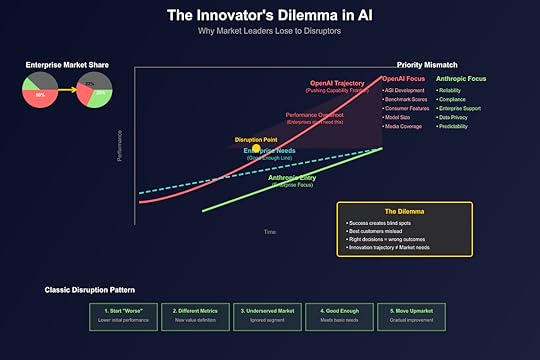The Innovator’s Dilemma in AI: Why OpenAI Lost Enterprise to Anthropic

Clayton Christensen’s Innovator’s Dilemma predicted exactly what’s happening in AI: the market leader’s greatest strengths become their greatest weaknesses. OpenAI’s fall from 50% enterprise market share to 25%, while Anthropic rose from 12% to 32%, isn’t a failure of execution—it’s the textbook playing out of disruption theory in real-time.
Understanding the Innovator’s DilemmaThe Innovator’s Dilemma describes how successful companies fail precisely because they do everything “right”:
Listen to their best customersInvest in highest-margin opportunitiesPursue sustaining innovationsOptimize for existing metricsYet these “right” decisions create blind spots that disruptors exploit.
OpenAI’s Success TrapThe Consumer GloryOpenAI built its dominance on consumer adoption:
ChatGPT: Fastest app to 100M usersGPT Store: Consumer ecosystem playMedia Dominance: Household name recognitionDeveloper Love: API-first approach for buildersThis success created organizational antibodies against enterprise priorities.
The Innovation TreadmillOpenAI’s innovation pace trapped them:
GPT-4 → GPT-5: Incremental improvements, not breakthroughsMultimodal Push: Features enterprises didn’t requestAGI Obsession: Distant vision over immediate valueResearch Culture: Papers over productsEach innovation cycle pulled resources from enterprise needs.
Anthropic’s Disruption PlaybookThe Classic Disruptor ProfileAnthropic exhibits every characteristic of Christensen’s disruptor:
Started “Worse”: Claude initially inferior to GPT-4Different Metrics: Safety and reliability over raw capabilityUnderserved Market: Enterprise security concernsFocused Innovation: Constitutional AI for complianceGood Enough: Met enterprise threshold requirementsThe Enterprise WedgeAnthropic attacked where OpenAI couldn’t respond:
Enterprise Requirements:
Predictable outputsAudit trailsData privacy guaranteesCompliance frameworksWhite-glove supportOpenAI’s Constraints:
Consumer scale complexityResearcher incentivesAGI narrative commitmentVenture growth expectationsThe Performance Trajectory DivergenceTraditional Innovation TheoryChristensen’s model shows two curves:
Technology Progress: Steep improvement slopeMarket Needs: Gradual requirement growthThe gap between them creates disruption opportunity.
The AI Market RealityOpenAI’s Trajectory:
Pushing the capability frontierOptimizing for benchmarksPursuing artificial general intelligenceMeasuring by model size and parametersEnterprise Needs Trajectory:
Reliability over capabilityIntegration over innovationCompliance over performancePredictability over possibilityAnthropic’s Position:
Met the enterprise “good enough” thresholdFocused on enterprise-specific improvementsIgnored consumer benchmark racesOptimized for boring but critical featuresVTDF Analysis: The Disruption DynamicsValue ArchitectureOpenAI Value: Maximum capability, breakthrough featuresAnthropic Value: Maximum reliability, enterprise fitMarket Value Shift: From “what’s possible” to “what works”Enterprise Priority: Predictability worth more than performanceTechnology StackOpenAI Tech: Cutting-edge models, research-drivenAnthropic Tech: Constitutional AI, safety-first architectureIntegration Reality: Enterprises need APIs, not AGITechnical Debt: OpenAI’s consumer scale creates enterprise frictionDistribution StrategyOpenAI Distribution: B2C viral, developer-led growthAnthropic Distribution: B2B enterprise sales, top-downChannel Conflict: OpenAI’s consumer success blocks enterprise focusSales Dynamics: Anthropic’s enterprise-only positioning wins trustFinancial ModelOpenAI Economics: Volume-based, consumer subsidizationAnthropic Economics: Value-based, enterprise premiumsMargin Structure: Enterprise willingness to pay 10x consumerInvestment Allocation: OpenAI funds moonshots, Anthropic funds reliabilityThe Resource Allocation TrapOpenAI’s DilemmaEvery dollar OpenAI spends faces competing priorities:
Consumer features vs enterprise requirementsResearch papers vs product stabilityAGI progress vs practical applicationsGlobal scale vs white-glove serviceThe loudest voice (consumers) wins resources.
Anthropic’s FocusAnthropic’s narrow focus enables concentration:
Only enterprise customers matterOnly safety and reliability countOnly B2B metrics drive decisionsOnly sustainable growth targetedThis focus creates compound advantages.
The Organizational AntibodiesOpenAI’s Cultural BarriersResearch Heritage:
Scientists optimizing for citationsEngineers chasing technical eleganceProduct teams serving developersLeadership selling AGI visionSuccess Metrics:
Model benchmark scoresUser growth ratesAPI call volumesMedia coverageThese metrics actively punish enterprise investment.
Anthropic’s Cultural AdvantagesEnterprise DNA:
Sales teams understanding complianceEngineers prioritizing stabilityProduct focusing on workflowsLeadership selling reliabilitySuccess Metrics:
Enterprise retentionCompliance certificationsUptime percentagesContract valuesThese metrics reinforce enterprise focus.
The Market Perception Shift2023: The Capability Race“Who has the best model?”“What’s the benchmark score?”“How many parameters?”“When is AGI?”OpenAI dominated this narrative.
2025: The Reliability Race“Who can we trust?”“What’s the uptime?”“How’s the compliance?”“Where’s the ROI?”Anthropic owns this narrative.
The Defensive ImpossibilityWhy OpenAI Can’t RespondChristensen’s framework explains why leaders rarely defeat disruption:
Margin Dilution: Enterprise support costs exceed consumer marginsChannel Conflict: Enterprise needs conflict with consumer featuresOrganizational Inertia: 10,000+ developers serving consumersInvestor Expectations: Growth story requires mass marketTechnical Debt: Consumer architecture blocks enterprise featuresThe Asymmetric CompetitionAnthropic can attack OpenAI’s enterprise market, but OpenAI can’t attack Anthropic’s:
Anthropic: “We’re enterprise-only” (credible)OpenAI: “We’re enterprise-focused” (not credible)This asymmetry determines the outcome.
Historical ParallelsMicrosoft vs. Google (Cloud)Microsoft’s enterprise DNA beat Google’s technical superiorityAzure’s enterprise features trumped GCP’s innovationBoring but reliable won over exciting but complexOracle vs. MongoDBMongoDB’s developer love couldn’t overcome Oracle’s enterprise lock-inFeatures developers wanted weren’t features enterprises boughtCompliance and support beat performance and eleganceSlack vs. Microsoft TeamsSlack’s consumer-style innovation lost to Teams’ enterprise integrationBetter product lost to better fitInnovation lost to distributionFuture ImplicationsThe OpenAI PredicamentOpenAI faces three paths:
Double Down on Consumer: Accept enterprise loss, dominate consumerSplit Focus: Create enterprise division (usually fails)Pivot Completely: Abandon consumer for enterprise (impossible)History suggests they’ll choose #1 after trying #2.
The Anthropic OpportunityAnthropic’s disruption playbook points toward:
Moving Upmarket: From SMB to Fortune 500Expanding Scope: From chat to workflow automationPlatform Play: Becoming the enterprise AI operating systemAcquisition Target: Microsoft/Google enterprise AI acquisitionThe Next DisruptorThe pattern will repeat. Anthropic’s enterprise success creates new vulnerabilities:
Open source models for cost-conscious enterprisesSpecialized models for vertical industriesEdge AI for data sovereignty requirementsRegional players for compliance needsLessons for LeadersFor IncumbentsRecognize the Dilemma: Success creates vulnerabilitySeparate Organizations: Innovation requires independenceDifferent Metrics: Measure new initiatives differentlyCannibalize Yourself: Better you than competitorsAccept Trade-offs: Can’t serve all markets equallyFor DisruptorsStart Humble: “Worse” product for overserved customersPick Your Battle: Focus beats breadthDefine New Metrics: Change the game’s rulesPatience Pays: Compound advantages take timeMove Upmarket: Gradually expand from footholdConclusion: The Inevitable InversionOpenAI’s loss of enterprise market share to Anthropic isn’t a failure—it’s physics. The Innovator’s Dilemma describes forces as fundamental as gravity in technology markets. OpenAI’s consumer success didn’t just distract from enterprise needs; it actively prevented addressing them.
The irony is perfect: OpenAI, disrupting the entire software industry with AI, is itself being disrupted in the enterprise segment. The company that made “GPT” a household name is losing to a company most households have never heard of.
This is the innovator’s dilemma in its purest form: doing everything right, succeeding by every metric, and losing the market precisely because of that success.
—
Keywords: innovator’s dilemma, Clayton Christensen, OpenAI, Anthropic, enterprise AI, disruption theory, market share, enterprise software, AI competition
Want to leverage AI for your business strategy?
Discover frameworks and insights at BusinessEngineer.ai
The post The Innovator’s Dilemma in AI: Why OpenAI Lost Enterprise to Anthropic appeared first on FourWeekMBA.



